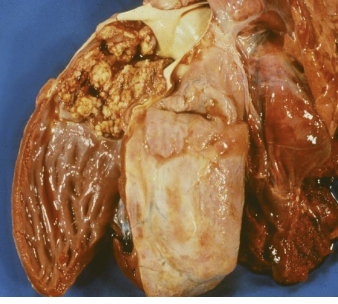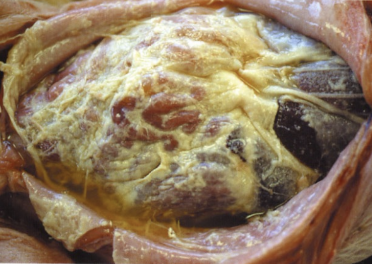Swine Nursery Pigs
1/43
Earn XP
Description and Tags
Flashcards covering nursery pig management, common diseases (Greasy Pig, Streptococcus suis, Glasser’s disease), PCVAD, edema disease, post-weaning E. coli diarrhea, and general prevention/treatment strategies from the lecture notes.
Name | Mastery | Learn | Test | Matching | Spaced |
|---|
No study sessions yet.
44 Terms
What is the recommended room temperature for nursery pigs and why is temperature important?
30°C is recommended; keeping pigs warm supports feed intake, growth, and reduces stress-related disease.
How much water should be available per nursery pigs and what other basic management supports are recommended?
Water: 1 unit per 10 pigs; provide highly digestible feed, adequate feeder space (1 per 5 pigs), clean environment, and feed all at once for the first 3 days after weaning.
What are the core performance targets for nursery pigs?
Mortality <2-3%; growth rate increases with age; pigs typically grow from ~5 kg at ~21 days to ~25-30 kg after ~7 weeks in nursery.
Why is enrichment important in preventing tail biting in nursery pigs?
Providing enrichment materials (chains, rubber hoses, straw, mushroom compost, maize silage) lowers tail biting and promotes welfare.
Name the three main nursery pig diseases
Staphylococcus hyicus (greasy pig disease)
Streptococcus suis (streptococcal meningitis)
Haemophilus parasuis (Glasser’s disease).
What organism causes greasy pig disease and is it zoonotic?
Staphylococcus hyicus; not zoonotic.
What is a key feature of greasy pig disease pathogenesis that explains skin lesions?
Exfoliative toxins produced by certain S. hyicus strains target the stratum granulosum, causing dermatitis and greasy exudate.
What are the typical clinical signs of Exudative Epidermitis (Greasy Pig)?
Dermatitis starting as brownish spots on the face, progressing to generalized lesions with greasy exudate and skin damage.
How is greasy pig disease diagnosed and treated?
Diagnosis: skin swab/culture; Treatment: topical antiseptics and systemic antibiotics guided by sensitivity; monitor hydration and nutrition.
What preventive measures can reduce greasy pig disease beyond treatment?
Minimize trauma and fighting (teeth clipping timing as per code), reduce mixing, maintain hygiene and humidity control, add heat to improve air exchange; vaccines of limited benefit in many cases.
What is the epidemiologic hallmark of Streptococcus suis infections in pigs and humans?
Stress and pre-existing disease precipitate infection; there are ~35 serotypes; Type 2 is most common and zoonotic.
At what age do Streptococcus suis infections typically onset in pigs?
Typically 5-10 weeks of age (nursery & grower stages).
List the main clinical forms of Streptococcus suis infection.
Peracute septicemia; Acute meningitis; Chronic arthritis; Valvular endocarditis.

What is the primary pathogenesis of Streptococcus suis meningitis?
Invasion of the blood-brain barrier leading to local inflammation and cytokine release, causing meningitis.
How is Streptococcus suis diagnosed and what samples are typically examined?
Culture and serotyping from brain, ventral brain, joints; look for cloudy meninges and septic lesions.
What are common treatment approaches for Streptococcus suis infections?
Parenteral antibiotics (high-dose penicillin, ceftiofur, trimethoprim-sulfa) and anti-inflammatories; isolate affected pigs; euthanasia if no response.
What is a key prevention strategy for Streptococcus suis and its limitations?
Mass antimicrobial medication in water/food to reduce spread; control stressors (crowding, ventilation, sanitation); vaccines are serotype-specific and often ineffective broadly.
Describe Glasser’s disease (Glaesserella parasuis) and its typical signs.
Porcine polyserositis and arthritis; fever, sudden death or convulsions, lameness; high mortality in naïve herds.
What are the characteristic gross lesions of Glasser’s disease?
Fibrinosuppurative polyserositis on multiple serosal surfaces

How is Glasser’s disease diagnosed and treated?
Diagnosis via culture and gross pathology; culture can be slow or difficult in treated animals; treatment includes parenteral antibiotics for sick pigs and mass prophylaxis; vaccination may help with serotypes but cross-protection is poor.
What role do vaccines play in Glasser’s disease prevention and control?
Vaccines must target correct serotypes; cross-protection is poor; autogenous vaccines are often used; maintain biosecurity and reduce stress.
What does PCVAD stand for and which virus is involved?
Porcine Circovirus Associated Diseases (PCVAD); associated with Porcine circovirus type 2 (PCV2).
What syndromes are included under PCVAD?
PMWS (Post-weaning Multisystemic Wasting Syndrome) and PDNS (Porcine Dermatopathy and Nephropathy Syndrome).
What is a typical clinical course and signs of PMWS?
Clinical signs include wasting, poor growth, anemia, enlarged lymph nodes, pallor, possible jaundice and dyspnea, ± enlarged spleen, ± spotted enlarged kidney, petechia; onset often around 6-8 weeks and can extend to grower phase.
Describe PDNS and its key features.
Porcine Dermatopathy and Nephropathy Syndrome; red to purple skin lesions on hindquarters and flanks; enlarged kidneys with white spots; immune-mediated vasculitis; pigs often die from secondary infections.
How is PCV2 diagnosed and confirmed in tissue samples?
Clinical signs plus gross pathology; PCR/RFLP; histology and immunohistochemistry showing abundant PCV2 in tissues; virus isolation is difficult.
What are the main PMWS/PCVAD control strategies?
Commercial piglet vaccines (1-2 doses) and sow vaccines; manage other diseases (e.g., PRRS); sanitation and ventilation; reduce mixing and improve stocking density; ensure good air/ environment quality.
What are the typical effects of PCV2 vaccination on production metrics?
Decreased mortality and viral load, increased ADG, reduced growth variation; vaccines are highly effective but not 100% preventive.
What causes post-weaning E. coli diarrhea and what is a common fimbrial type involved?
Enterotoxigenic E. coli (ETEC); commonly Fimbrial type F4 (K88) associated with most outbreaks.
Name the main toxins produced by post-weaning E. coli and their types.
STa, STb, LT, and VT (enterotoxins).
What are major risk factors for post-weaning E. coli diarrhea in nursery pigs?
Weaning stress, declining immunity, changes in GI flora, dietary changes, and environmental stress.
DDx for neurologic signs: paddling
Edema disease → VTEC, Shiga-like toxin
Strep suis
Describe the clinical signs of post-weaning E. coli diarrhea.
Pasty to watery diarrhea, depression, irritated perineum, distended abdomen, sunken eyes; sometimes sudden death and dehydration.
How is post-weaning E. coli diarrhea diagnosed and differentiated from other diseases?
History of recent weaning; clinical signs; necropsy showing fluid-filled intestines and dehydration; culture/serotyping; histology showing bacteria in intestines and vascular changes.
What feed and water management strategies help prevent post-weaning E. coli diarrhea?
High-quality ingredients; avoid poorly digested carbohydrates; acidify GI tract with feed or water; add fiber; zinc oxide (1500-3000 ppm) though usage is changing; limit high protein intake.
What are current considerations for zinc oxide and antibiotic use in PWECD prevention?
Zinc oxide use is increasingly restricted; resistance concerns; antibiotics like Avilamycin and others used based on sensitivity results; follow evolving regulations (2026/27 changes referenced).
What environmental management practices help reduce edema disease risk?
Maintain stable temperatures, reduce drafts, avoid overcrowding, sanitize to reduce environmental stress and bacterial proliferation; clean water lines and disinfect with chlorine.
Describe edema disease (E. coli Stx2e) and its pathogenesis.
Verotoxigenic E. coli produces Shiga-like toxin (Stx2e);
Fatal enterotoxemia → toxins damage arteries causing edema in various sites, including brain, colon, stomach; disease occurs 1-3 weeks after weaning.
What are common clinical signs of edema disease and prognosis?
Unthriftiness of high proportion, anorexia, nervous signs (ataxia, paddling), eyelid edema, squeaky voice; death within 24 hours; herd courses typically ~2 weeks.
How is edema disease diagnosed and controlled?
Clinical signs plus necropsy edema; culture of small intestine; genotyping for Stx2e; control via improved husbandry, possible antibiotics, and vaccines (autogenous/commercial) where available; minimize stresses.
What is the role of environmental and sanitation factors in nursery disease control overall?
Cleanliness is critical; disinfectants are less effective in presence of organic matter; maintain clean water lines; reduce humidity and high temperatures that promote bacterial growth.
Why is it important to minimize mixing and ensure AIAO in nursery pigs?
Reduces disease transmission and stress; helps maintain immune status and growth performance by limiting exposure to pathogens.
What is the significance of ‘bread & butter’ lesions in Glasser’s disease pathology?
They refer to the characteristic fibrinous polyserositis on multiple serosal surfaces, a hallmark gross finding in Glasser’s disease.
What is the main differential diagnosis consideration for Glasser’s disease in pigs?
Multisystemic illness with rapid progression; differentials include Streptococcus suis infections and Staphylococcus infections; culture and gross pathology help distinguish.